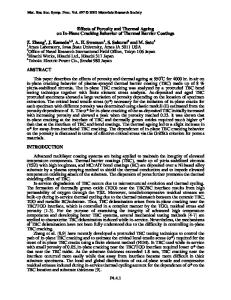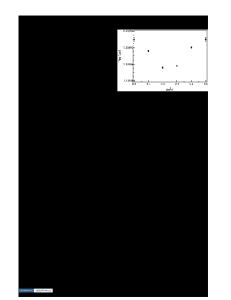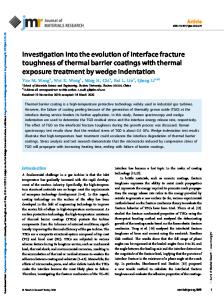Analysis of Residual Stress and Damage Durability with Thermal Fatigue Behavior in Thermal Barrier Coatings
- PDF / 489,180 Bytes
- 6 Pages / 612 x 792 pts (letter) Page_size
- 81 Downloads / 438 Views
P8.18.1
Analysis of Residual Stress and Damage Durability with Thermal Fatigue Behavior in Thermal Barrier Coatings Dong-Ho Park1, Hyung-Jun Jang1, Yeon-Gil Jung1, Jung-Chel Chang2, and Ungyu Paik3 1
Dept. of Ceramic Science and Engineering, Changwon National University 9 Sarim-dong, Changwon, Kyungnam 641-773, Korea 2 Power Generation Lab, Korea Electric Power Research Institute 103-16 Munji-dong, Yusung-ku, Daejon 305-380, Korea 3 Dept. of Ceramic Engineering, Hanyang University 17 Haengdang-dong, Seongdong-gu, Seoul 133-791, Korea ABSTRACT Static thermal fatigue tests for thermal barrier coatings (TBCs) were conducted to observe effects of temperature and holding time on its mechanical properties, hardness and modulus, and damage durability. For which three TBCs samples with different thickness in bonding layer (0.08, 0.14, and 0.28 mm) were prepared using an air plasma spraying (APS) method. Temperature of 950 and 1100oC and holding time of 10 and 100 hr were selected for the thermal fatigue tests. The TBCs with thin bonding layer (0.08 mm) maintain sound condition for all the thermal fatigue tests, even showing an evidence of cracking at the interface between coating and bonding layers. However, the TBCs with intermediate (0.14 mm) and thick (0.28 mm) bonding layers show delamination at interface and fracture of coating layer after the thermal fatigue tests at 1100 oC for 100 hr. Thermal growth oxide (TGO) layer is created at the interface between coating and bonding layers in all the TBCs after the thermal fatigue tests, and the TGO layer thickness is mainly affected by temperature. Modulus and hardness of coating layer are increased with an increase of temperature in the thermal fatigue tests, due to the re-sintering of coating layer during the thermal fatigue tests. Effects of bonding layer thickness and thermal fatigue condition on mechanical properties, residual stresses, damage durability of the TBCs are discussed extensively.
INTRODUCTION The advanced multi-layered ceramic coatings applied on metallic substrates are generally used as thermal barrier coatings (TBCs) in gas turbine and diesel engine components. Demands for improving performance of the turbine and the engine are met in part by increasing and decreasing the combustion and cooling temperatures, respectively [1]. However, an increase of temperature difference within the turbine and the engine leads to service limits in current TBCs and superalloys [2,3]. Therefore, estimation and understanding for properties of TBCs, such as thermal behavior, residual stresses, and damage tolerance, are essential for improving its reliability and lifetime. TBCs consisting of yttria-doped stabilized zirconia (YSZ) top coating layer and Ni-based alloy bonding layer are being widely used to enhance fuel efficiency in internal combustion engines, which are subjected to severe working conditions in elevated temperature environments.
P8.18.2
In present work, in order to evaluate and compare mechanical properties and thermal durability of TBCs in thermal enviro
Data Loading...











